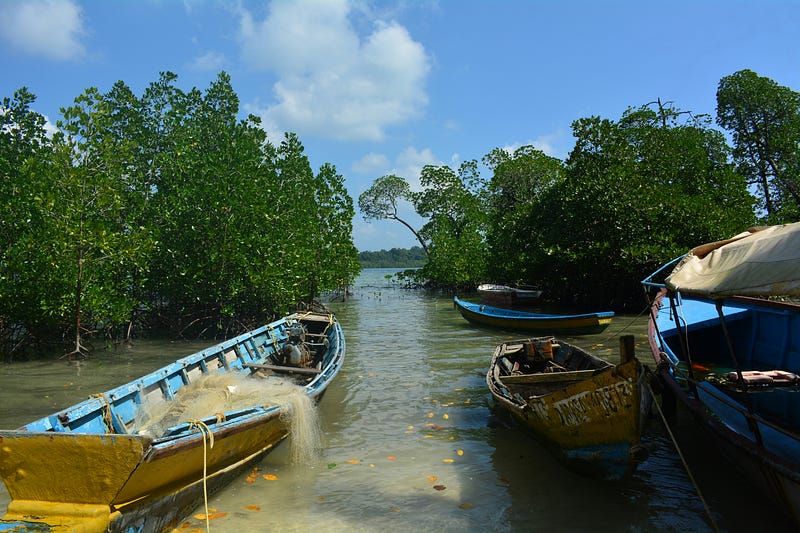Conserving Coastal Treasures: The Importance of Mangrove Ecosystems
Written on
Chapter 1: Understanding Mangroves
When you think of forests, you might picture dense clusters of trees on a hillside. However, forests can take many forms, including a unique variety found in marine environments. Mangrove forests thrive along tropical and subtropical coastlines, serving as vital guardians of coastal ecosystems. This article will delve into the essential ecosystem services provided by mangrove forests, enhancing life on our planet.
What Exactly Are Mangroves?
Mangroves are specialized coastal ecosystems that flourish in the intertidal zone—the area where land meets the sea. Comprising hardy tree species, these forests are uniquely adapted to survive in flooded soils and high salinity conditions. While often referred to as salt forests, their ecological significance and biodiversity extend well beyond this label. Found predominantly in tropical and subtropical regions, mangroves play an integral role in safeguarding coastlines, supporting local communities, and regulating numerous natural processes.
Ecosystem Services Offered by Mangroves
Despite their often-overlooked presence, mangrove forests deliver a wide range of ecosystem services crucial for human life and the environment.
Provisioning Services
- Fisheries: Mangroves serve as nurseries, providing habitat for fish, crustaceans, and mollusks, which are vital protein sources for coastal populations.
- Forest Products: The wood from mangroves is used in construction, and various non-timber products such as tannins and resins are harvested.
Regulating Services
- Coastal Protection: Acting as natural barriers, mangroves mitigate coastal erosion and shield against storms. Their dense root systems and trunks dissipate wave energy, safeguarding nearby beaches and settlements.
- Water Regulation: The roots and soil of mangroves filter and purify freshwater before it enters marine ecosystems, crucial for maintaining water quality and protecting sensitive habitats like coral reefs.
Supporting Services
- Biodiversity Habitat: Mangroves provide essential habitats for a diverse array of species, including plants, fish, crustaceans, birds, and mammals. These ecosystems are key reproductive and nursery grounds, supporting local fisheries and biodiversity conservation.
- Carbon Sequestration: Mangroves are remarkably effective at sequestering carbon within their biomass and soils. Research indicates that these ecosystems capture carbon at rates ten times higher than mature tropical forests, significantly contributing to climate change mitigation.
Cultural Services
- Tourism and Recreation: Mangroves draw tourists interested in activities like birdwatching, kayaking, and exploring nature, generating economic benefits for local communities.
- Cultural Connectivity: For many coastal populations, mangroves hold deep cultural significance, intertwined with local traditions and beliefs.

Mangroves by the Numbers
A meta-analysis of research revealed that the ecosystem services of mangroves are valued at approximately $21,100 per hectare. The most extensive mangrove coverage can be found in Indonesia, encompassing around 31,000 square kilometers—an area comparable to that of a small nation.
Interesting Facts about Mangrove Forests
- Mangrove leaves can taste salty due to the high salinity of their growing environment; some species excrete salt to prevent toxicity.
- When navigating through a mangrove forest, it's wise to avoid standing still in one spot for too long, as you may find yourself stuck in the mud. If you need to pause, seek support from a root or fallen trunk.

Challenges Facing Mangroves
Despite their immense value, mangroves are under threat from deforestation linked to agriculture and aquaculture, pollution, urban development, and climate change. Ensuring their conservation and sustainable management is critical for maintaining the benefits they provide to both human communities and the environment.
Mangroves are invaluable coastal ecosystems offering essential services that support both wildlife and human life. Protecting these ecosystems is crucial for ensuring a sustainable future for coastal populations and the health of marine habitats. The next time you find yourself near a mangrove forest, take a moment to appreciate its vital role in the ecosystem.
“Only if we understand, will we care. Only if we care, will we help. Only if we help shall all be saved.” — Jane Goodall